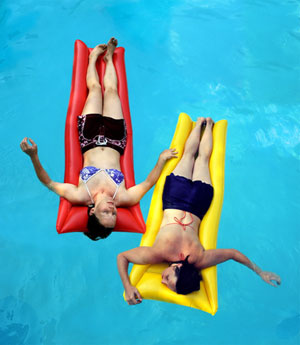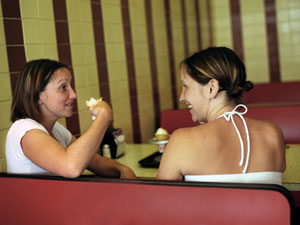Baudrillard stated that photos were different from paintings in that they were read as being true.
Simply put, a photo is a document, a painting is an image. Having seen photo images from Space Jam and the Terminator series, I intellectually understand that a photographic image is as malleable as paint.
Kelli Connell undermined this confidence in with the manipulated images displayed in Summer, Barry Whistler Gallery. All of the images are constructed by editing and combining images digitally. Each of the photos depicts two women. Both women are portraits of thesame model. Several elements of Connell’s work allows her to trump the mind. First, she combines the images flawlessly: leaving the viewer no visual hint that they are two separate images. Second, in most of the photos the women look different. Small changes in the model’s hair, facial express, and dress create a viable illusion of two different women. More importantly, Connell appropriates the conventions of snapshot photography to create this illusion. In almost every shot the figures fill up about 3⁄4 of the picture frame and are placed in a clunky perspective. Second, all of the photos are of a female couple, doing amazingly pedestrian things: i.e. reading a road map in the cabin of a car outside a burger joint, sunbathing, or standing outside a broken down car calling for help. On a fundamental level, the truth of the photos as documents is an irrelevant issue. The measure of Connell’s work is its ability to create a fiction that tells a truth.
Connell understands relationships. A relationship is a single context between two individuals. At moments, those two individuals are in sync. But there are as many moments where they misfire. Relationships are clumsy things, filled with misunderstandings. Connell depicts this dynamic brilliantly in two images: Mr. Frosty, a photo of two women sitting in an ice cream parlor, and 4th of July, in which the two women play with sparklers.
In Mr. Frosty, the figures have two different reactions to whatever was just said. The figure to the left sits with her shoulders facing the other and a half eaten ice cream cone in her hand. Her eyebrows arched and her mouth is opened in a look of bewilderment. The figure looks slightly agitated. The figure on the right is turned with her head facing the other, smiling broadly almost as if she is laughing. This image depicts a single, albeit slight, miscommunication between the two figures. This lack of communication has a bittersweet overtone in 4th of July. The figure on the right is fixated on the sparkler in her hand. Smiling joyfully seemingly lost in the moment. The figure on the left holds up her sparkler but her gaze is fixed on the other. She has a pensive and preoccupied look on her face. It seems like a bittersweet image of a moment which one partner feels intensely and that intensity is not reciprocated. This narrative is accented by the space the women are in- a vast and vacant landscape.
Lesbianism is the main subject of only one photo. Window Shopping depicts two women in lawn chairs sitting on front of a display window. The image is saturated with images of identity and conforming to a social norm. In the display window, there is a manikin dressed up in a proper blue pleated dress. The figure is fitted with white short gloves and a flamboyant purse. The woman on the left is dressed up as a cowboy dyke. Complete with a straw hat, denim shorts and a t-shirt with “Official Bikini Inspector: Hawaii” printed on it, with its sleeves rolled up to its armpits. The figure on the right is dressed in a conservativeblack top and checkerboard skirt. The items in the window are provocative. There is a book with the title “How to make”. It is set immediately behind a decapitated female manikin head. On the image’s far right is an unknown object with the word “sins” printed on it. The photo also includes two pink flamingos: icons of homosexual kitsch. The innate misogyny of putting the text “how to make love” directly above a decapitated head is both confusing and troubling. The whole image is set off by the word "sins". It is one of the few references to contemporary or current political times, where a member of congress will openly equate consensual homosexual intercourse with pedophilia. Connell leaves the viewers nothing to wrap their mind around. There is no way to congeal these images into some message. Like life, this photograph includes images of cruelty, kitsch and conformity. Like in life, these elements collide and recoil like bumper cars. Connell gives the viewer no resolution.
All of the images in Summer are of two women. Her works does not deal with Lesbians exclusively. Her work deals with narratives that reflect the lives of all people. After all, straight men and women and gay men all get lost, have their cars break down, eat ice cream, fight, love more then they are loved and lay around a pool. Through this her work reflects and can connect with all people. Connell’s photos lie as documents but tell truths as images.
Images courtesy Barry Whistler Gallery.
Tony Merino is a writer living in Dallas.





